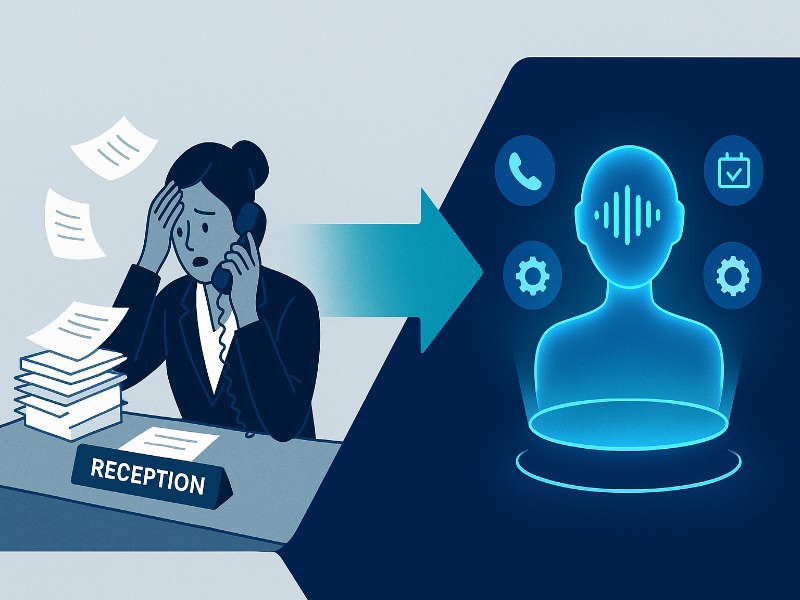- Step-by-Step Guide to AI Receptionist Migration
- AI Receptionist Setup Process
- Migrating from Receptionist to AI System: Industry Examples
- Customer Success Metrics
- AI vs Human Receptionist: Feature Comparison
- Best Practices for AI Receptionist Onboarding
- Training Staff to Work with AI Receptionist
- Smooth Transition to AI Receptionist: Implementation Checklist
- Cost of Switching to AI Receptionist
- Integration Best Practices
- Change Management for a Smooth Transition
- AI Receptionist Migration Timeline
- Why Choose welco.ai?
- Ready to Transform Your Front Desk?
- Frequently Asked Questions
How to Switch from Human to AI Receptionist: Complete Migration Guide

Imagine running a business where every customer call is answered instantly—no voicemails piling up, no staff scrambling at the front desk, and no revenue lost from missed calls. That’s exactly what an AI receptionist delivers.
This comprehensive guide explains how to migrate from a traditional human receptionist to an AI receptionist system. You’ll learn setup processes, cost breakdowns, onboarding strategies, and best practices to ensure a smooth, successful transition.
We’ll also answer the most common questions businesses have about AI receptionist migration and explain why welco.ai offers the fastest, most employee-friendly approach to making the switch.
Step-by-Step Guide to AI Receptionist Migration
Switching from a human to an AI receptionist requires thoughtful planning. Here’s the proven process successful businesses follow:
1. Evaluate Current Operations
Document your receptionist’s daily responsibilities: answering calls, scheduling appointments, transferring calls, and handling FAQs. This assessment identifies which tasks AI should manage and which still require human oversight.
2. Select the Right Platform
Look for solutions that offer:
- Quick setup (under 30 minutes with platforms like welco.ai) – studies show 73% faster deployment than traditional phone systems
- Seamless phone system integration (VoIP, SIP, or call forwarding)
- CRM and calendar connectivity (Google Calendar, Salesforce, HubSpot)
- Flexible pricing that scales with call volume – typically 60-80% lower than human receptionist costs according to industry benchmarks.
3. Upload Business Information
Prepare business hours, service details, pricing, and FAQs with answers. AI receptionists rely on this structured data to respond accurately to callers.
Essential information to upload includes:
- Business hours in 15-minute increments (e.g., “Monday-Friday 8:00 AM – 6:00 PM”)
- Complete service menu with pricing (formatted as: Service Name | Duration | Price)
- Top 20 frequently asked questions with exact scripted responses
- Staff names, titles, and availability schedules
- Holiday schedules and emergency contact procedures
- CRM integration requirements and data field mapping
4. Personalize Scripts and Voice
Customize communication style to match your brand. Adjust greetings, escalation rules, and language preferences so the AI feels like part of your team.
5. Test Before Launch
Run simulated calls to confirm speech recognition accuracy, call transfer functionality, and appointment booking. Gather feedback, refine scripts, and address gaps.
6. Launch Gradually
Start with a hybrid approach—AI handles routine calls while staff manage complex cases. Gradually expand until AI manages 70–80% of calls independently.
AI Receptionist Setup Process
AI receptionist setup involves 4 core steps and takes 30 minutes to 2 hours depending on integration complexity. Setting up an AI receptionist is far simpler than hiring and training new staff. With welco.ai, most businesses go live in under 30 minutes
The process typically includes:
- Connecting your phone system (via SIP, VoIP, or call forwarding)
- Syncing calendars for real-time scheduling
- Integrating your CRM for caller recognition
- Testing scripts in real-world call scenarios
Migrating from Receptionist to AI System: Industry Examples
Healthcare: Pediatric clinics and family practices use AI receptionists to book appointments, handle prescription refill requests, and reduce no-shows by 25-30% by syncing with patient reminder systems
Legal Firms: Law offices rely on AI receptionists to pre-qualify callers, gather case details, and route inquiries to the right attorney—improving client intake efficiency by 35-40% and reducing after-hours missed calls by 85%.
Retail & Services: Spas, salons, and repair shops use AI to manage peak-hour call surges. One salon chain reported a 60% reduction in missed calls and 45% improvement in appointment booking rates after migrating to an AI receptionist.
Customer Success Metrics
Healthcare Practice: A multi-location urgent care center achieved 68% cost reduction within the first year of AI receptionist adoption.
Legal Firm: Reduced new client intake delays by 35-40% after integrating AI call routing.
Retail Chain: Increased appointment bookings by 50% in the first quarter post-migration.
AI vs Human Receptionist: Feature Comparison
| Feature | Human Receptionist | AI Receptionist (welco.ai) |
| Availability | 9–5, limited coverage | 24/7, no breaks or sick days |
| Call Handling | One call at a time | Hundreds simultaneously |
| Appointment Scheduling | Manual, prone to errors | Automated, real-time sync |
| Call Transfers | Manual and time-consuming | Instant, seamless routing |
| Cost | $37k–$58k/year + benefits | $25–$3,000/month (usage-based) |
| Consistency & Accuracy | Varies with mood, workload | 100% consistent responses |
| Scalability | Requires hiring more staff | Scales instantly with call volume |
Best Practices for AI Receptionist Onboarding
Five best practices ensure successful AI receptionist onboarding: hybrid rollout, early staff training, customer feedback monitoring, weekly performance analysis, and regular information updates. Follow these best practices for onboarding:
Training Staff to Work with AI Receptionist
Employee buy-in is critical. Training should help staff see AI as an assistant, not a replacement:
- Show benefits: AI takes repetitive tasks, freeing staff for higher-value work. For example, instead of answering 50+ daily ‘what are your hours’ calls, staff can focus on complex customer service issues, sales follow-ups, or administrative tasks that require human judgment.
- Provide clear guides: Cover escalation triggers, monitoring, FAQs
- Practice together:Let employees test AI as callers. Set up role-playing scenarios where staff call in with different requests (appointment booking, pricing questions, complaints) to see how AI responds and when it escalates to humans. Practice scenarios include: angry customer calls, complex scheduling requests, technical service inquiries, and emergency situations.
- Encourage feedback: Involve staff in continuous improvement
Smooth Transition to AI Receptionist: Implementation Checklist
✅ To make migration seamless, we’ve prepared a downloadable AI Receptionist Migration Checklist (PDF). Use it as a step-by-step guide for setup, training, and rollout. Download the Checklist Here
Cost of Switching to AI Receptionist
So what does migration really cost?
- Human receptionist: $37,000–$58,000/year with benefits
- AI receptionist: $25–$3,000/month depending on usage
- Per call: Human $3–$6.50 vs AI $0.25–$0.50 per minute
- ROI: Achieved within 3–6 months
This cost advantage makes AI feasible for businesses of all sizes.
Integration Best Practices
For maximum efficiency, ensure your AI connects seamlessly with:
- Phone systems: VoIP, SIP, or call forwarding
- Calendars: Google or Outlook for scheduling
- CRMs: Caller recognition and personalization
- Business tools: Slack, Teams, project management platforms
Change Management for a Smooth Transition
Transitioning from human to AI receptionist requires strong change management:
- Address concerns directly: Explain AI’s role in reducing repetitive work
- Communicate transparently: Share rollout timelines and goals
- Implement gradually: Phase in capabilities step by step
- Offer support: Retraining and role adjustments keep staff engaged
AI Receptionist Migration Timeline
Typical timeline:
- Week 1: Setup + integrations
- Week 2: Customize scripts + train staff
- Week 3: Pilot program in hybrid mode
- Week 4: Full rollout + monitoring
Why Choose welco.ai?
Unlike generic platforms, welco.ai is built for businesses that can’t afford to miss calls.
Advantages include:
- 30-minute setup vs weeks with traditional providers
- Industry-specific training for healthcare, legal, retail, and service businesses
- Effortless integrations with calendars, CRMs, and phone systems
- Scalable pricing aligned to business growth
- True 24/7 availability for capturing every call
Ready to Transform Your Front Desk?
Migrating from human to AI receptionist doesn’t have to be complicated. With the right strategy and partner, you’ll reduce costs, increase efficiency, and improve customer experience—all within weeks.
👉 Discover how welco.ai can help you make the switch smoothly today.
Frequently Asked Questions
How much does it cost to switch from a human to an AI receptionist?
Most businesses pay $25-$3,000/month (vs. $37,000-$58,000/year for human receptionists), with ROI achieved in 3–6 months. The exact cost depends on call volume, features needed, and integration complexity. Small businesses typically start at $25-$200/month, while enterprise solutions range $500-$3,000/month.
What are the steps to implement an AI receptionist system?
Evaluate workflows, select a platform, integrate with phone/CRM systems, customize scripts, train staff, run pilot tests, then roll out fully.
How long does AI receptionist migration take?
Initial setup takes 30 minutes to 2 hours. Full migration spans 2–4 weeks and includes: Week 1 (system setup and integration), Week 2 (script customization and staff training), Week 3 (pilot testing in hybrid mode), Week 4 (full rollout and performance monitoring). Complex integrations with multiple CRM systems may extend the timeline to 6 weeks.
Can an AI receptionist completely replace a human receptionist?
AI can manage 70–80% of calls. Humans remain essential for complex or sensitive cases.
What best practices ensure a smooth transition?
Use a gradual rollout, align scripts with your brand, train staff early, and monitor analytics weekly.
